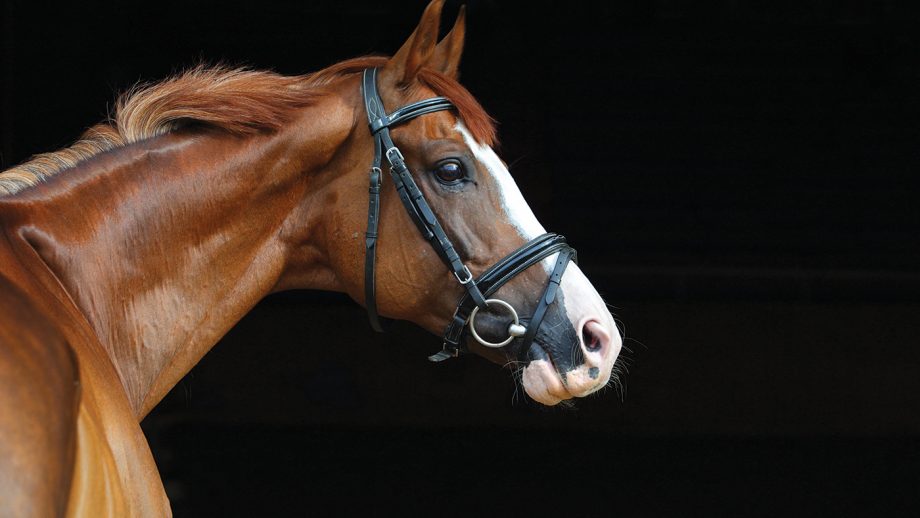From grassroots to championships, keeping competitors infection-free requires a robust routine. Lesley Barwise-Munro MRCVS explains
TRAVELLING to and staying away at shows again is an exciting prospect. To ensure a healthy, infection-free season, however, we must undertake thorough preparation to protect our competition horses from a variety of potential health threats.
The outbreak of the equine herpes virus-1 (EHV-1) paralytic strain this year in Europe was an extreme example, highlighting the risk of rapid spread of an infectious disease at a show.
Biosecurity – the term for the good hygiene practices that prevent disease transmission – must start at home. This means every yard should have an isolation system for newly purchased horses and short-stay visitors. Ideally, each incoming horse should undergo testing for strangles, equine influenza (flu) and EHV, prior to integration.
{"content":"PHA+Q3VycmVudGx5LCB0aGVyZSBpcyBhIGhlYWx0aCBkZWNsYXJhdGlvbiBmb3JtIHRvIGNvbXBsZXRlIGZvciBhbGwgY29tcGV0aXRpb25zLCB0byBjZXJ0aWZ5IHRoYXQgaG9yc2VzIGFycml2aW5nIGF0IGEgY29tcGV0aXRpb24gaGF2ZSBubyBrbm93biBzaWducyBvZiBpbGxuZXNzIGFuZCBoYXZlIG5vdCBoYWQgY29udGFjdCB3aXRoIGFueSBpbmZlY3Rpb3VzIGRpc2Vhc2VzLiBUaGlzIHJlbGllcyBvbiB0aGUgaG9uZXN0eSBhbmQgdmlnaWxhbmNlIG9mIG93bmVycyBpbiBvYnNlcnZpbmcgdGhlaXIgaG9yc2VzIGluIHRoZSBydW4tdXAgdG8gdGhlIHNob3csIHdoaWNoIHNob3VsZCBpbmNsdWRlIHRlbXBlcmF0dXJlLXRha2luZyBhdCBsZWFzdCBvbmNlIGEgZGF5IGZvciBhIHdlZWsgb3Igc28gaW4gYWR2YW5jZS48L3A+CjxkaXYgaWQ9ImF0dGFjaG1lbnRfNzQ2NjY2IiBzdHlsZT0id2lkdGg6IDE0MTBweCIgY2xhc3M9IndwLWNhcHRpb24gYWxpZ25ub25lIj48aW1nIGZldGNocHJpb3JpdHk9ImhpZ2giIGRlY29kaW5nPSJhc3luYyIgYXJpYS1kZXNjcmliZWRieT0iY2FwdGlvbi1hdHRhY2htZW50LTc0NjY2NiIgY2xhc3M9Imxhenlsb2FkIGJsdXItdXAgc2l6ZS1mdWxsIHdwLWltYWdlLTc0NjY2NiIgZGF0YS1wcm9jZXNzZWQgc3JjPSJodHRwczovL2tleWFzc2V0cy50aW1laW5jdWsubmV0L2luc3BpcmV3cC9saXZlL3dwLWNvbnRlbnQvdXBsb2Fkcy9zaXRlcy8xNC8yMDE3LzAzL25ldy1oaC1wbGFjZWhvbGRlci0yMDB4MjAwLnBuZyIgZGF0YS1zcmM9Imh0dHBzOi8va2V5YXNzZXRzLnRpbWVpbmN1ay5uZXQvaW5zcGlyZXdwL2xpdmUvd3AtY29udGVudC91cGxvYWRzL3NpdGVzLzE0LzIwMjEvMDUvSEFIMzA3LnZldF8uX2RzYzY5OThfdGlfYXJjaGl2ZS5qcGciIGFsdD0idHJhdmVsLCBsb3JyeS4gaG9yc2Vib3gsIGxvYWRpbmciIHdpZHRoPSIxNDAwIiBoZWlnaHQ9Ijc4OCIgZGF0YS1zaXplcz0iYXV0byIgZGF0YS1zcmNzZXQ9Imh0dHBzOi8va2V5YXNzZXRzLnRpbWVpbmN1ay5uZXQvaW5zcGlyZXdwL2xpdmUvd3AtY29udGVudC91cGxvYWRzL3NpdGVzLzE0LzIwMjEvMDUvSEFIMzA3LnZldF8uX2RzYzY5OThfdGlfYXJjaGl2ZS5qcGcgMTQwMHcsIGh0dHBzOi8va2V5YXNzZXRzLnRpbWVpbmN1ay5uZXQvaW5zcGlyZXdwL2xpdmUvd3AtY29udGVudC91cGxvYWRzL3NpdGVzLzE0LzIwMjEvMDUvSEFIMzA3LnZldF8uX2RzYzY5OThfdGlfYXJjaGl2ZS0zMDB4MTY5LmpwZyAzMDB3LCBodHRwczovL2tleWFzc2V0cy50aW1laW5jdWsubmV0L2luc3BpcmV3cC9saXZlL3dwLWNvbnRlbnQvdXBsb2Fkcy9zaXRlcy8xNC8yMDIxLzA1L0hBSDMwNy52ZXRfLl9kc2M2OTk4X3RpX2FyY2hpdmUtNjMweDM1NS5qcGcgNjMwdywgaHR0cHM6Ly9rZXlhc3NldHMudGltZWluY3VrLm5ldC9pbnNwaXJld3AvbGl2ZS93cC1jb250ZW50L3VwbG9hZHMvc2l0ZXMvMTQvMjAyMS8wNS9IQUgzMDcudmV0Xy5fZHNjNjk5OF90aV9hcmNoaXZlLTEzNXg3Ni5qcGcgMTM1dywgaHR0cHM6Ly9rZXlhc3NldHMudGltZWluY3VrLm5ldC9pbnNwaXJld3AvbGl2ZS93cC1jb250ZW50L3VwbG9hZHMvc2l0ZXMvMTQvMjAyMS8wNS9IQUgzMDcudmV0Xy5fZHNjNjk5OF90aV9hcmNoaXZlLTMyMHgxODAuanBnIDMyMHcsIGh0dHBzOi8va2V5YXNzZXRzLnRpbWVpbmN1ay5uZXQvaW5zcGlyZXdwL2xpdmUvd3AtY29udGVudC91cGxvYWRzL3NpdGVzLzE0LzIwMjEvMDUvSEFIMzA3LnZldF8uX2RzYzY5OThfdGlfYXJjaGl2ZS02MjB4MzQ5LmpwZyA2MjB3LCBodHRwczovL2tleWFzc2V0cy50aW1laW5jdWsubmV0L2luc3BpcmV3cC9saXZlL3dwLWNvbnRlbnQvdXBsb2Fkcy9zaXRlcy8xNC8yMDIxLzA1L0hBSDMwNy52ZXRfLl9kc2M2OTk4X3RpX2FyY2hpdmUtOTIweDUxOC5qcGcgOTIwdywgaHR0cHM6Ly9rZXlhc3NldHMudGltZWluY3VrLm5ldC9pbnNwaXJld3AvbGl2ZS93cC1jb250ZW50L3VwbG9hZHMvc2l0ZXMvMTQvMjAyMS8wNS9IQUgzMDcudmV0Xy5fZHNjNjk5OF90aV9hcmNoaXZlLTEyMjB4Njg3LmpwZyAxMjIwdyIgc2l6ZXM9IihtYXgtd2lkdGg6IDE0MDBweCkgMTAwdncsIDE0MDBweCIgLz48cCBpZD0iY2FwdGlvbi1hdHRhY2htZW50LTc0NjY2NiIgY2xhc3M9IndwLWNhcHRpb24tdGV4dCI+Q2xlYW5pbmcgYW5kIGRpc2luZmVjdGluZyB0aGUgbG9ycnkgb3IgdHJhaWxlciBhZnRlciBhIHNob3cgaXMgYSBnb29kIGJpb3NlY3VyaXR5IG1lYXN1cmU8L3A+PC9kaXY+CjxwPjxkaXYgY2xhc3M9ImFkLWNvbnRhaW5lciBhZC1jb250YWluZXItLW1vYmlsZSI+PGRpdiBpZD0icG9zdC1pbmxpbmUtMiIgY2xhc3M9ImlwYy1hZHZlcnQiPjwvZGl2PjwvZGl2PjxzZWN0aW9uIGlkPSJlbWJlZF9jb2RlLTMxIiBjbGFzcz0iaGlkZGVuLW1kIGhpZGRlbi1sZyBzLWNvbnRhaW5lciBzdGlja3ktYW5jaG9yIGhpZGUtd2lkZ2V0LXRpdGxlIHdpZGdldF9lbWJlZF9jb2RlIHByZW1pdW1faW5saW5lXzIiPjxzZWN0aW9uIGNsYXNzPSJzLWNvbnRhaW5lciBsaXN0aW5nLS1zaW5nbGUgbGlzdGluZy0tc2luZ2xlLXNoYXJldGhyb3VnaCBpbWFnZS1hc3BlY3QtbGFuZHNjYXBlIGRlZmF1bHQgc2hhcmV0aHJvdWdoLWFkIHNoYXJldGhyb3VnaC1hZC1oaWRkZW4iPg0KICA8ZGl2IGNsYXNzPSJzLWNvbnRhaW5lcl9faW5uZXIiPg0KICAgIDx1bD4NCiAgICAgIDxsaSBpZD0ibmF0aXZlLWNvbnRlbnQtbW9iaWxlIiBjbGFzcz0ibGlzdGluZy1pdGVtIj4NCiAgICAgIDwvbGk+DQogICAgPC91bD4NCiAgPC9kaXY+DQo8L3NlY3Rpb24+PC9zZWN0aW9uPjwvcD4KPHA+SW50ZXJuYXRpb25hbCBldmVudGVyIDxhIGhyZWY9Imh0dHBzOi8vd3d3LmhvcnNlYW5kaG91bmQuY28udWsvdGFnL29saXZlci10b3duZW5kIiB0YXJnZXQ9Il9ibGFuayIgcmVsPSJub29wZW5lciBub3JlZmVycmVyIj5PbGl2ZXIgVG93bmVuZDwvYT4gaXMgYSBncmVhdCBhZHZvY2F0ZSBvZiBiaW9zZWN1cml0eS4gSGF2aW5nIHJlY2VudGx5IHRyYXZlbGxlZCB0d28gaG9yc2VzIHRvIHRoZSBLZW50dWNreSBmaXZlLXN0YXIgaW4gdGhlIFVTIOKAkyBDb29sZXkgTWFzdGVyIENsYXNzIGFuZCBldmVudHVhbCB3aW5uZXIgQmFsbGFnaG1vciBDbGFzcyAocGljdHVyZWQgaW4gYWN0aW9uIGF0IEJhZG1pbnRvbiwgbGVmdCkg4oCTIHRoZSBUb3duZW5kIHRlYW0gcXVpdGUgcmlnaHRseSBwcmlkZXMgaXRzZWxmIG9uIGVmZmVjdGl2ZSBxdWFyYW50aW5lIGFuZCBwcmVwYXJhdGlvbiBvZiBob3JzZXMgZm9yIHRvcC1sZXZlbCBjb21wZXRpdGlvbi48L3A+CjxwPkF0IGhvbWUsIE9saXZlciBydW5zIGEgYmFybiBzeXN0ZW0gd2hlcmUgaG9yc2VzIGFyZSBzdGFibGVkIGluIHNtYWxsIGdyb3Vwcywgc28gbWV0aWN1bG91cyBiaW9zZWN1cml0eSBtZWFzdXJlcyBjYW4gYmUgYXBwbGllZCBhbmQgYW55IGhlYWx0aCBpc3N1ZXMgY2FuIGJlIHN3aWZ0bHkgZGVhbHQgd2l0aC4gRWFjaCBiYXJuIGhhcyBpdHMgb3duIGVxdWlwbWVudCwgd2hpY2ggaXMgcmVndWxhcmx5IGRpc2luZmVjdGVkLCBhbmQgZ3Jvb21zIGhhdmUgYSBoaWdoIHN0YW5kYXJkIG9mIGh5Z2llbmUuPC9wPgo8cD7igJxXZSBhcmUgaW5jcmVkaWJseSBjYXJlZnVsIGFib3V0IHRoZSBpc29sYXRpb24gb2Ygb3VyIGhvcnNlcyzigJ0gaGUgZXhwbGFpbnMuIOKAnFZpc2l0b3JzIGFuZCBhbnkgZ3Jvb21zIG90aGVyIHRoYW4gdGhlIGhvcnNlc+KAmSBvd24gaGF2ZSBtaW5pbXVtIGNvbnRhY3Qgd2l0aCB0aGVtLCBib3RoIGF0IHRoZSB5YXJkIGFuZCBhd2F5LiBUZW1wZXJhdHVyZXMgYXJlIHRha2VuIGRhaWx5IGF0IGhvbWUsIGFuZCBhdCBsZWFzdCB0d2ljZSBhIGRheSB3aGVuIGF3YXkgYXQgY29tcGV0aXRpb25zIOKAkyBhbmQgZm9yIDQ4IGhvdXJzIHVwb24gcmV0dXJuLuKAnTwvcD4KPGRpdiBjbGFzcz0iYWQtY29udGFpbmVyIGFkLWNvbnRhaW5lci0tbW9iaWxlIj48ZGl2IGlkPSJwb3N0LWlubGluZS0zIiBjbGFzcz0iaXBjLWFkdmVydCI+PC9kaXY+PC9kaXY+CjxwPjxpbWcgZGVjb2Rpbmc9ImFzeW5jIiBjbGFzcz0ibGF6eWxvYWQgYmx1ci11cCBhbGlnbm5vbmUgc2l6ZS1mdWxsIHdwLWltYWdlLTc0NjY3MiIgZGF0YS1wcm9jZXNzZWQgc3JjPSJodHRwczovL2tleWFzc2V0cy50aW1laW5jdWsubmV0L2luc3BpcmV3cC9saXZlL3dwLWNvbnRlbnQvdXBsb2Fkcy9zaXRlcy8xNC8yMDE3LzAzL25ldy1oaC1wbGFjZWhvbGRlci0yMDB4MjAwLnBuZyIgZGF0YS1zcmM9Imh0dHBzOi8va2V5YXNzZXRzLnRpbWVpbmN1ay5uZXQvaW5zcGlyZXdwL2xpdmUvd3AtY29udGVudC91cGxvYWRzL3NpdGVzLzE0LzIwMjEvMDUvSEFIMzA3LnZldF8udG93bmVuZF95YXJkX2ZtLmpwZWciIGFsdD0iIiB3aWR0aD0iMTQwMCIgaGVpZ2h0PSI3ODgiIGRhdGEtc2l6ZXM9ImF1dG8iIGRhdGEtc3Jjc2V0PSJodHRwczovL2tleWFzc2V0cy50aW1laW5jdWsubmV0L2luc3BpcmV3cC9saXZlL3dwLWNvbnRlbnQvdXBsb2Fkcy9zaXRlcy8xNC8yMDIxLzA1L0hBSDMwNy52ZXRfLnRvd25lbmRfeWFyZF9mbS5qcGVnIDE0MDB3LCBodHRwczovL2tleWFzc2V0cy50aW1laW5jdWsubmV0L2luc3BpcmV3cC9saXZlL3dwLWNvbnRlbnQvdXBsb2Fkcy9zaXRlcy8xNC8yMDIxLzA1L0hBSDMwNy52ZXRfLnRvd25lbmRfeWFyZF9mbS0zMDB4MTY5LmpwZWcgMzAwdywgaHR0cHM6Ly9rZXlhc3NldHMudGltZWluY3VrLm5ldC9pbnNwaXJld3AvbGl2ZS93cC1jb250ZW50L3VwbG9hZHMvc2l0ZXMvMTQvMjAyMS8wNS9IQUgzMDcudmV0Xy50b3duZW5kX3lhcmRfZm0tNjMweDM1NS5qcGVnIDYzMHcsIGh0dHBzOi8va2V5YXNzZXRzLnRpbWVpbmN1ay5uZXQvaW5zcGlyZXdwL2xpdmUvd3AtY29udGVudC91cGxvYWRzL3NpdGVzLzE0LzIwMjEvMDUvSEFIMzA3LnZldF8udG93bmVuZF95YXJkX2ZtLTEzNXg3Ni5qcGVnIDEzNXcsIGh0dHBzOi8va2V5YXNzZXRzLnRpbWVpbmN1ay5uZXQvaW5zcGlyZXdwL2xpdmUvd3AtY29udGVudC91cGxvYWRzL3NpdGVzLzE0LzIwMjEvMDUvSEFIMzA3LnZldF8udG93bmVuZF95YXJkX2ZtLTMyMHgxODAuanBlZyAzMjB3LCBodHRwczovL2tleWFzc2V0cy50aW1laW5jdWsubmV0L2luc3BpcmV3cC9saXZlL3dwLWNvbnRlbnQvdXBsb2Fkcy9zaXRlcy8xNC8yMDIxLzA1L0hBSDMwNy52ZXRfLnRvd25lbmRfeWFyZF9mbS02MjB4MzQ5LmpwZWcgNjIwdywgaHR0cHM6Ly9rZXlhc3NldHMudGltZWluY3VrLm5ldC9pbnNwaXJld3AvbGl2ZS93cC1jb250ZW50L3VwbG9hZHMvc2l0ZXMvMTQvMjAyMS8wNS9IQUgzMDcudmV0Xy50b3duZW5kX3lhcmRfZm0tOTIweDUxOC5qcGVnIDkyMHcsIGh0dHBzOi8va2V5YXNzZXRzLnRpbWVpbmN1ay5uZXQvaW5zcGlyZXdwL2xpdmUvd3AtY29udGVudC91cGxvYWRzL3NpdGVzLzE0LzIwMjEvMDUvSEFIMzA3LnZldF8udG93bmVuZF95YXJkX2ZtLTEyMjB4Njg3LmpwZWcgMTIyMHciIHNpemVzPSIobWF4LXdpZHRoOiAxNDAwcHgpIDEwMHZ3LCAxNDAwcHgiIC8+PC9wPgo8aDM+VFJJUCBIQVpBUkRTPC9oMz4KPHA+V0hJTEUgaW50ZXJuYXRpb25hbCBjb21wZXRpdGlvbiBicmluZ3MgaXRzIG93biBjaGFsbGVuZ2VzLCBhbnkga2luZCBvZiBnYXRoZXJpbmcgb2YgaG9yc2VzIGZyb20gZGlmZmVyZW50IHlhcmRzIHdpbGwgaW5jcmVhc2UgdGhlIHJpc2sgb2YgaW5mZWN0aW9uIHNwcmVhZC48L3A+CjxkaXYgY2xhc3M9ImFkLWNvbnRhaW5lciBhZC1jb250YWluZXItLW1vYmlsZSI+PGRpdiBpZD0icG9zdC1pbmxpbmUtNCIgY2xhc3M9ImlwYy1hZHZlcnQiPjwvZGl2PjwvZGl2Pgo8cD5NYWtlIHN1cmUgdGhhdCB5b3VyIGhvcnNl4oCZcyB2YWNjaW5hdGlvbnMgY29tcGx5IHdpdGggdGhlIHJlcXVpcmVtZW50cyBvZiB5b3VyIHJlZ2lzdGVyZWQgZGlzY2lwbGluZS4gUGxhbiBhaGVhZCwgYXMgRkVJIHJ1bGVzIHN0aXB1bGF0ZSB0aGF0IGEgaG9yc2Ugc2hvdWxkIG5vdCBiZSB2YWNjaW5hdGVkIGZvciBmbHUgd2l0aGluIHNldmVuIGRheXMgcHJpb3IgdG8gZW50ZXJpbmcgdGhlIGNvbXBldGl0aW9uIHN0YWJsZXMuPC9wPgo8cD5GbHUgYW5kIEVIViB2YWNjaW5hdGlvbnMgd2lsbCBoZWxwIHRvIHByb3RlY3QgYWdhaW5zdCB0aGVzZSBkaXNlYXNlcy4gV2hpbGUgdGhlcmUgaXMgbm8gc3BlY2lmaWMgdmFjY2luYXRpb24gYWdhaW5zdCB0aGUgRUhWLTEgcGFyYWx5dGljIGZvcm0sIGl0IGlzIHRob3VnaHQgdGhlcmUgaXMgc29tZSBwcm90ZWN0aW9uIGZvciB2YWNjaW5hdGVkIGhvcnNlcyB0aHJvdWdoIGhlcmQgaW1tdW5pdHkuPC9wPgo8ZGl2IGNsYXNzPSJhZC1jb250YWluZXIgYWQtY29udGFpbmVyLS1tb2JpbGUiPjxkaXYgaWQ9InBvc3QtaW5saW5lLTUiIGNsYXNzPSJpcGMtYWR2ZXJ0Ij48L2Rpdj48L2Rpdj4KPHA+S2VlcCB0aGUgbG9ycnkgd2VsbCB2ZW50aWxhdGVkLiBJdCBpcyBhZHZpc2FibGUgbm90IHRvIHNoYXJlIHRyYW5zcG9ydCB3aXRoIGhvcnNlcyBmcm9tIGRpZmZlcmVudCB5YXJkcyBhbmQsIGlmIHBvc3NpYmxlLCB0byB0cmF2ZWwgdG8gY29tcGV0aXRpb25zIGRhaWx5IHRvIGF2b2lkIHRoZSByaXNrIG9mIGNyb3NzLWluZmVjdGlvbiB3aXRoIG90aGVycyBpbiBzaG93IHN0YWJsaW5nLjwvcD4KPHA+SW5mZWN0aW9uIGlzIG5vdCBvbmx5IHRyYW5zbWl0dGVkIGRpcmVjdGx5LCB0aHJvdWdoIGhvcnNlLXRvLWhvcnNlIGNvbnRhY3QsIGJ1dCBhbHNvIGluZGlyZWN0bHksIG9uIGhhbmRzLCB0YWNrIG9yIG90aGVyIGVxdWlwbWVudC4gV2hpbGUgdmlyYWwgcGFydGljbGVzIGFuZCBiYWN0ZXJpYSBjYW4gbGl2ZSBpbiBhbiBlbnZpcm9ubWVudCBmb3Igc2V2ZXJhbCBkYXlzLCB0aGV5IGNhbiBiZSBraWxsZWQgd2l0aCBkaXNpbmZlY3RhbnQuPC9wPgo8cD5XaGVyZSBhbiBvdmVybmlnaHQgc3RheSBpcyBuZWNlc3NhcnksIHN0cmluZ2VudCBoeWdpZW5lIG1lYXN1cmVzIGFyZSByZWNvbW1lbmRlZC4gSWYgeW91ciBob3JzZSBpcyB0aGUgZmlyc3QgaW50byBuZXcgdGVtcG9yYXJ5IHN0YWJsaW5nLCBvbiBncmFzcywgYW5kIHRoZSBzaGF2aW5ncyBiYWxlcyBwcm92aWRlZCBhcmUgdW5vcGVuZWQsIHRoaXMgc2hvdWxkIGJlIGZpbmUgaW4gdGVybXMgb2YgYmlvc2VjdXJpdHkuIFVzZWQgYmVkZGluZyBjYW4gYmUgYSBkaXNlYXNlIHRyYW5zbWlzc2lvbiByaXNrLCBob3dldmVyLCBpbiB0ZXJtcyBvZiBuYXNhbCBkaXNjaGFyZ2Ugb3IgY291Z2hlZCBhZXJvc29sIGRyb3BsZXRzLCBzbyB0YWtlIHlvdXIgb3duIGlmIGl0IGlzIGZlYXNpYmxlIHRvIHBhY2sgc29tZSBpbiB0aGUgbG9ycnkuPC9wPgo8cD5BIGhvcnNlIGNhbiBsaWNrIG9yIG51enpsZSBhbnl3aGVyZSwgc28gdHJlYXQgdGhlIHN0YWJsZSBzdXJmYWNlcyB3aXRoIGFuIGFwcHJvdmVkIGRpc2luZmVjdGFudCBzdWNoIGFzIFZpcmtvbi4gUHJldmVudCBub3NlLXRvLW5vc2UgY29udGFjdCB3aXRoIG5laWdoYm91cnMsIGVpdGhlciB0aHJvdWdoIG9yIG92ZXIgdGhlIHRvcCBvZiBzdGFibGUgd2FsbHMg4oCTIHNlY3VyZSBzb21lIHdhdGVycHJvb2YgbWF0ZXJpYWwgd2l0aCBjYWJsZS10aWVzLCBpbiB0aGUgYWJzZW5jZSBvZiBhbnl0aGluZyBzcGVjaWZpY2FsbHkgZGVzaWduZWQuPC9wPgo8cD5Vc2UgeW91ciBvd24gZXF1aXBtZW50LCBhbmQgY2xlYW4geW91ciBoYW5kcyByZWd1bGFybHkgd2l0aCBhbnRpYmFjdGVyaWFsIGdlbC4gU2luY2UgY29tbXVuYWwgaG9zZSBwaXBlcyBwb3RlbnRpYWxseSBoYXJib3VyIGluZmVjdGlvbiwgdGFrZSBhIHN1cHBseSBvZiB3YXRlciB3aXRoIHlvdS4gSWYgeW91IG11c3QgdXNlIGEgc2hhcmVkIGhvc2UgcGlwZSwgZGlzaW5mZWN0IHRoZSBlbmQgcmVndWxhcmx5LjwvcD4KPGRpdiBpZD0iYXR0YWNobWVudF83NDY2NjkiIHN0eWxlPSJ3aWR0aDogMTQxMHB4IiBjbGFzcz0id3AtY2FwdGlvbiBhbGlnbm5vbmUiPjxpbWcgZGVjb2Rpbmc9ImFzeW5jIiBhcmlhLWRlc2NyaWJlZGJ5PSJjYXB0aW9uLWF0dGFjaG1lbnQtNzQ2NjY5IiBjbGFzcz0ibGF6eWxvYWQgYmx1ci11cCBzaXplLWZ1bGwgd3AtaW1hZ2UtNzQ2NjY5IiBkYXRhLXByb2Nlc3NlZCBzcmM9Imh0dHBzOi8va2V5YXNzZXRzLnRpbWVpbmN1ay5uZXQvaW5zcGlyZXdwL2xpdmUvd3AtY29udGVudC91cGxvYWRzL3NpdGVzLzE0LzIwMTcvMDMvbmV3LWhoLXBsYWNlaG9sZGVyLTIwMHgyMDAucG5nIiBkYXRhLXNyYz0iaHR0cHM6Ly9rZXlhc3NldHMudGltZWluY3VrLm5ldC9pbnNwaXJld3AvbGl2ZS93cC1jb250ZW50L3VwbG9hZHMvc2l0ZXMvMTQvMjAyMS8wNS9IQUgzMDcudmV0Xy5iYWRtaW50b25faHRfeGNfMjAxOF81NF8xOTU0NjA1NDJfMjU2MDA2MDgyX3RpX2FyY2hpdmUuanBnIiBhbHQ9Ik9saXZlciBUb3duZW5kICsgQmFsbGFnaG1vciBDbGFzcyBhdCB0aGUgRGV2b3VvY291eCBRdWFkIEJhciIgd2lkdGg9IjE0MDAiIGhlaWdodD0iNzg4IiBkYXRhLXNpemVzPSJhdXRvIiBkYXRhLXNyY3NldD0iaHR0cHM6Ly9rZXlhc3NldHMudGltZWluY3VrLm5ldC9pbnNwaXJld3AvbGl2ZS93cC1jb250ZW50L3VwbG9hZHMvc2l0ZXMvMTQvMjAyMS8wNS9IQUgzMDcudmV0Xy5iYWRtaW50b25faHRfeGNfMjAxOF81NF8xOTU0NjA1NDJfMjU2MDA2MDgyX3RpX2FyY2hpdmUuanBnIDE0MDB3LCBodHRwczovL2tleWFzc2V0cy50aW1laW5jdWsubmV0L2luc3BpcmV3cC9saXZlL3dwLWNvbnRlbnQvdXBsb2Fkcy9zaXRlcy8xNC8yMDIxLzA1L0hBSDMwNy52ZXRfLmJhZG1pbnRvbl9odF94Y18yMDE4XzU0XzE5NTQ2MDU0Ml8yNTYwMDYwODJfdGlfYXJjaGl2ZS0zMDB4MTY5LmpwZyAzMDB3LCBodHRwczovL2tleWFzc2V0cy50aW1laW5jdWsubmV0L2luc3BpcmV3cC9saXZlL3dwLWNvbnRlbnQvdXBsb2Fkcy9zaXRlcy8xNC8yMDIxLzA1L0hBSDMwNy52ZXRfLmJhZG1pbnRvbl9odF94Y18yMDE4XzU0XzE5NTQ2MDU0Ml8yNTYwMDYwODJfdGlfYXJjaGl2ZS02MzB4MzU1LmpwZyA2MzB3LCBodHRwczovL2tleWFzc2V0cy50aW1laW5jdWsubmV0L2luc3BpcmV3cC9saXZlL3dwLWNvbnRlbnQvdXBsb2Fkcy9zaXRlcy8xNC8yMDIxLzA1L0hBSDMwNy52ZXRfLmJhZG1pbnRvbl9odF94Y18yMDE4XzU0XzE5NTQ2MDU0Ml8yNTYwMDYwODJfdGlfYXJjaGl2ZS0xMzV4NzYuanBnIDEzNXcsIGh0dHBzOi8va2V5YXNzZXRzLnRpbWVpbmN1ay5uZXQvaW5zcGlyZXdwL2xpdmUvd3AtY29udGVudC91cGxvYWRzL3NpdGVzLzE0LzIwMjEvMDUvSEFIMzA3LnZldF8uYmFkbWludG9uX2h0X3hjXzIwMThfNTRfMTk1NDYwNTQyXzI1NjAwNjA4Ml90aV9hcmNoaXZlLTMyMHgxODAuanBnIDMyMHcsIGh0dHBzOi8va2V5YXNzZXRzLnRpbWVpbmN1ay5uZXQvaW5zcGlyZXdwL2xpdmUvd3AtY29udGVudC91cGxvYWRzL3NpdGVzLzE0LzIwMjEvMDUvSEFIMzA3LnZldF8uYmFkbWludG9uX2h0X3hjXzIwMThfNTRfMTk1NDYwNTQyXzI1NjAwNjA4Ml90aV9hcmNoaXZlLTYyMHgzNDkuanBnIDYyMHcsIGh0dHBzOi8va2V5YXNzZXRzLnRpbWVpbmN1ay5uZXQvaW5zcGlyZXdwL2xpdmUvd3AtY29udGVudC91cGxvYWRzL3NpdGVzLzE0LzIwMjEvMDUvSEFIMzA3LnZldF8uYmFkbWludG9uX2h0X3hjXzIwMThfNTRfMTk1NDYwNTQyXzI1NjAwNjA4Ml90aV9hcmNoaXZlLTkyMHg1MTguanBnIDkyMHcsIGh0dHBzOi8va2V5YXNzZXRzLnRpbWVpbmN1ay5uZXQvaW5zcGlyZXdwL2xpdmUvd3AtY29udGVudC91cGxvYWRzL3NpdGVzLzE0LzIwMjEvMDUvSEFIMzA3LnZldF8uYmFkbWludG9uX2h0X3hjXzIwMThfNTRfMTk1NDYwNTQyXzI1NjAwNjA4Ml90aV9hcmNoaXZlLTEyMjB4Njg3LmpwZyAxMjIwdyIgc2l6ZXM9IihtYXgtd2lkdGg6IDE0MDBweCkgMTAwdncsIDE0MDBweCIgLz48cCBpZD0iY2FwdGlvbi1hdHRhY2htZW50LTc0NjY2OSIgY2xhc3M9IndwLWNhcHRpb24tdGV4dCI+QmFsbGFnaG1vciBDbGFzczwvcD48L2Rpdj4KPGgzPldPUks6RkVFRCBSQVRJT1M8L2gzPgo8cD5BRERJVElPTkFMIGhlYWx0aCBpc3N1ZXMgY2FuIGNyb3AgdXAuIFRvIHJlZHVjZSB0aGUgcmlzayBvZiB0aGUgbXVzY2xlIGNvbmRpdGlvbiBleGVydGlvbmFsIHJoYWJkb215b2x5c2lzIChrbm93biBhcyB0eWluZyB1cCwgb3IgYXpvdHVyaWEpLCBtYWtlIGEgd29yayBwbGFuIHJpZ2h0IHVwIHRvIHRoZSBkYXkgb2YgdHJhdmVsIOKAkyBhbmQgZHVyaW5nIHRoZSBhd2F5IHN0YXkuPC9wPgo8cD5UaGVyZSBhcmUgc29tZXRpbWVzIOKAnGVhc3kgZGF5c+KAnSBhdCBzaG93cywgYnV0IG1haW50YWluIGEgaG9yc2XigJlzIHdvcmsgYW5kIGRpZXRhcnkgYmFsYW5jZS4gRm9sbG93IGEgcHJvcGVyIHdhcm0tdXAgYW5kIGNvb2wtZG93biByb3V0aW5lIHRvIGFzc2lzdCBtdXNjbGUgcmVjb3ZlcnkgYW5kIHJlcGFpci48L3A+CjxwPuKAnFdlIGtlcHQgdGhlIHR3byBob3JzZXMgdGhhdCB3ZXJlIHRyYXZlbGxpbmcgdG8gS2VudHVja3kgYXMgZml0IGFzIHBvc3NpYmxlLCByaWdodCB1cCB0byB0aGUgcG9pbnQgb2Ygc2V0dGluZyBvZmYsIGtub3dpbmcgdGhhdCB0aGV5IGhhZCB0byBnbyBpbnRvIHF1YXJhbnRpbmUgd2hlcmUgdGhlIHdvcmsgbGV2ZWwgYW5kIGZlZWQgd291bGQgYmUgcmVkdWNlZCzigJ0gT2xpdmVyIHJlcG9ydHMuPC9wPgo8cD5Tb21lIGhvcnNlcyBkbyBub3QgbGlrZSBhIGNoYW5nZSBvZiB3YXRlciwgc28gZW5jb3VyYWdlIGEgcG9vciBkcmlua2VyIHRvIHN0YXkgaHlkcmF0ZWQgdG8gYXZvaWQgaW1wYWN0aW9uIGNvbGljLjwvcD4KPHA+Qmlvc2VjdXJpdHkgbWVhc3VyZXMgc2hvdWxkIGNvbnRpbnVlIGF0IGhvbWUsIHdoZXJlIHRob3JvdWdoIGRpc2luZmVjdGluZyBvZiBhbGwgZXF1aXBtZW50IOKAkyBpbmNsdWRpbmcgdGhlIGxvcnJ5IG9yIHRyYWlsZXIg4oCTIGlzIHJlY29tbWVuZGVkLiBJc29sYXRlIGEgcmV0dXJuaW5nIGNvbXBldGl0b3IgZm9yIGEgbWluaW11bSBvZiB0d28gd2Vla3MsIHdoZXJlIHBvc3NpYmxlLCBtb25pdG9yaW5nIGZvciBhIHJhaXNlZCB0ZW1wZXJhdHVyZSBvciBzaWducyBvZiBzaWNrbmVzcywgdG8gbGVzc2VuIHRoZSByaXNrIG9mIGluZmVjdGluZyBvdGhlciBob3JzZXMuPC9wPgo8ZGl2IGlkPSJhdHRhY2htZW50Xzc0NjY2NyIgc3R5bGU9IndpZHRoOiAxNDEwcHgiIGNsYXNzPSJ3cC1jYXB0aW9uIGFsaWdubm9uZSI+PGltZyBsb2FkaW5nPSJsYXp5IiBkZWNvZGluZz0iYXN5bmMiIGFyaWEtZGVzY3JpYmVkYnk9ImNhcHRpb24tYXR0YWNobWVudC03NDY2NjciIGNsYXNzPSJsYXp5bG9hZCBibHVyLXVwIHNpemUtZnVsbCB3cC1pbWFnZS03NDY2NjciIGRhdGEtcHJvY2Vzc2VkIHNyYz0iaHR0cHM6Ly9rZXlhc3NldHMudGltZWluY3VrLm5ldC9pbnNwaXJld3AvbGl2ZS93cC1jb250ZW50L3VwbG9hZHMvc2l0ZXMvMTQvMjAxNy8wMy9uZXctaGgtcGxhY2Vob2xkZXItMjAweDIwMC5wbmciIGRhdGEtc3JjPSJodHRwczovL2tleWFzc2V0cy50aW1laW5jdWsubmV0L2luc3BpcmV3cC9saXZlL3dwLWNvbnRlbnQvdXBsb2Fkcy9zaXRlcy8xNC8yMDIxLzA1L0hBSDMwNy52ZXRfLjJmNGU0eTlfYWxhbXkuanBnIiBhbHQ9IjJGNEU0WTkgVGVtcG9yYXJ5IHN0YWJsZXMgZm9yIGhvcnNlcyB3aXRoIGVxdWlwbWVudCBoYW5naW5nIG9uIGV4dGVyaW9yLCIgd2lkdGg9IjE0MDAiIGhlaWdodD0iNzg4IiBkYXRhLXNpemVzPSJhdXRvIiBkYXRhLXNyY3NldD0iaHR0cHM6Ly9rZXlhc3NldHMudGltZWluY3VrLm5ldC9pbnNwaXJld3AvbGl2ZS93cC1jb250ZW50L3VwbG9hZHMvc2l0ZXMvMTQvMjAyMS8wNS9IQUgzMDcudmV0Xy4yZjRlNHk5X2FsYW15LmpwZyAxNDAwdywgaHR0cHM6Ly9rZXlhc3NldHMudGltZWluY3VrLm5ldC9pbnNwaXJld3AvbGl2ZS93cC1jb250ZW50L3VwbG9hZHMvc2l0ZXMvMTQvMjAyMS8wNS9IQUgzMDcudmV0Xy4yZjRlNHk5X2FsYW15LTMwMHgxNjkuanBnIDMwMHcsIGh0dHBzOi8va2V5YXNzZXRzLnRpbWVpbmN1ay5uZXQvaW5zcGlyZXdwL2xpdmUvd3AtY29udGVudC91cGxvYWRzL3NpdGVzLzE0LzIwMjEvMDUvSEFIMzA3LnZldF8uMmY0ZTR5OV9hbGFteS02MzB4MzU1LmpwZyA2MzB3LCBodHRwczovL2tleWFzc2V0cy50aW1laW5jdWsubmV0L2luc3BpcmV3cC9saXZlL3dwLWNvbnRlbnQvdXBsb2Fkcy9zaXRlcy8xNC8yMDIxLzA1L0hBSDMwNy52ZXRfLjJmNGU0eTlfYWxhbXktMTM1eDc2LmpwZyAxMzV3LCBodHRwczovL2tleWFzc2V0cy50aW1laW5jdWsubmV0L2luc3BpcmV3cC9saXZlL3dwLWNvbnRlbnQvdXBsb2Fkcy9zaXRlcy8xNC8yMDIxLzA1L0hBSDMwNy52ZXRfLjJmNGU0eTlfYWxhbXktMzIweDE4MC5qcGcgMzIwdywgaHR0cHM6Ly9rZXlhc3NldHMudGltZWluY3VrLm5ldC9pbnNwaXJld3AvbGl2ZS93cC1jb250ZW50L3VwbG9hZHMvc2l0ZXMvMTQvMjAyMS8wNS9IQUgzMDcudmV0Xy4yZjRlNHk5X2FsYW15LTYyMHgzNDkuanBnIDYyMHcsIGh0dHBzOi8va2V5YXNzZXRzLnRpbWVpbmN1ay5uZXQvaW5zcGlyZXdwL2xpdmUvd3AtY29udGVudC91cGxvYWRzL3NpdGVzLzE0LzIwMjEvMDUvSEFIMzA3LnZldF8uMmY0ZTR5OV9hbGFteS05MjB4NTE4LmpwZyA5MjB3LCBodHRwczovL2tleWFzc2V0cy50aW1laW5jdWsubmV0L2luc3BpcmV3cC9saXZlL3dwLWNvbnRlbnQvdXBsb2Fkcy9zaXRlcy8xNC8yMDIxLzA1L0hBSDMwNy52ZXRfLjJmNGU0eTlfYWxhbXktMTIyMHg2ODcuanBnIDEyMjB3IiBzaXplcz0iKG1heC13aWR0aDogMTQwMHB4KSAxMDB2dywgMTQwMHB4IiAvPjxwIGlkPSJjYXB0aW9uLWF0dGFjaG1lbnQtNzQ2NjY3IiBjbGFzcz0id3AtY2FwdGlvbi10ZXh0Ij5QcmV2ZW50IG5vc2UtdG8tbm9zZSBjb250YWN0IHdpdGggb3RoZXIgaG9yc2VzIGF0IHNob3cgc3RhYmxpbmc8L3A+PC9kaXY+CjxoMz5CdXN0IHN0cmVzcyB0byBib29zdCBpbW11bml0eTwvaDM+CjxwPlNPTUUgaG9yc2VzIHRyYXZlbCB3ZWxsLCB3aGlsZSBvdGhlcnMgYmVjb21lIHN0cmVzc2VkIGJ5IHRoZSBleHBlcmllbmNlLiBTdHJlc3MgaXMgdGhvdWdodCB0byBoYXZlIHNvbWUgaW1wYWN0IG9uIHRoZSBpbW11bmUgc3lzdGVtLCBtYWtpbmcgYSBob3JzZSBtb3JlIHN1c2NlcHRpYmxlIHRvIGluZmVjdGlvdXMgZGlzZWFzZS4gQnkgbWFpbnRhaW5pbmcgaGlzIHJvdXRpbmUgYW5kIG1pbmltaXNpbmcgdGhlIGVmZmVjdHMgb2Ygc3RyZXNzLCB0aGUgYmV0dGVyIHRoZSBjaGFuY2VzIHRoYXQgaGUgd2lsbCBjb21wZXRlIHRvIGhpcyBmdWxsIHBvdGVudGlhbC48L3A+CjxwPkluIHRoZSBydW4tdXAgdG8gYSBzaG93LCBncmFkdWFsbHkgaW50cm9kdWNlIHRoZSBoYXlsYWdlIGEgaG9yc2Ugd2lsbCBiZSBlYXRpbmcgd2hpbGUgYXdheS4gVGhpcyBtYXkgbWVhbiBjaGFuZ2luZyBmcm9tIGEgYmlnIGJhbGUgdG8gc21hbGxlciwgbW9yZSBjb252ZW5pZW50IGJhbGVzIE9yLCBhcyB0aGUgVG93bmVuZCB0ZWFtIGRvZXMsIHRha2Ugc21hbGwgYmFsZXMgd2l0aCB5b3UgbWFkZSBmcm9tIHRoZSBzYW1lIGhheWxhZ2UgYXMgdGhlIGJpZyBiYWxlcy48L3A+CjxwPjxpbWcgbG9hZGluZz0ibGF6eSIgZGVjb2Rpbmc9ImFzeW5jIiBjbGFzcz0ibGF6eWxvYWQgYmx1ci11cCBhbGlnbm5vbmUgc2l6ZS1mdWxsIHdwLWltYWdlLTc0NjY3MCIgZGF0YS1wcm9jZXNzZWQgc3JjPSJodHRwczovL2tleWFzc2V0cy50aW1laW5jdWsubmV0L2luc3BpcmV3cC9saXZlL3dwLWNvbnRlbnQvdXBsb2Fkcy9zaXRlcy8xNC8yMDE3LzAzL25ldy1oaC1wbGFjZWhvbGRlci0yMDB4MjAwLnBuZyIgZGF0YS1zcmM9Imh0dHBzOi8va2V5YXNzZXRzLnRpbWVpbmN1ay5uZXQvaW5zcGlyZXdwL2xpdmUvd3AtY29udGVudC91cGxvYWRzL3NpdGVzLzE0LzIwMjEvMDUvSEFIMzA3LnZldF8uYm94X2JhbGxhZ2htb3JfY2xhc3NfMzI3NDEwNjkyXzUyMzI3MDQwMl90aV9hcmNoaXZlLmpwZWciIGFsdD0iQmFsbGFnaG1vciBDbGFzcyBpbiBFcXVpIFRyZWsgbG9ycnkiIHdpZHRoPSIxNDAwIiBoZWlnaHQ9Ijc4OCIgZGF0YS1zaXplcz0iYXV0byIgZGF0YS1zcmNzZXQ9Imh0dHBzOi8va2V5YXNzZXRzLnRpbWVpbmN1ay5uZXQvaW5zcGlyZXdwL2xpdmUvd3AtY29udGVudC91cGxvYWRzL3NpdGVzLzE0LzIwMjEvMDUvSEFIMzA3LnZldF8uYm94X2JhbGxhZ2htb3JfY2xhc3NfMzI3NDEwNjkyXzUyMzI3MDQwMl90aV9hcmNoaXZlLmpwZWcgMTQwMHcsIGh0dHBzOi8va2V5YXNzZXRzLnRpbWVpbmN1ay5uZXQvaW5zcGlyZXdwL2xpdmUvd3AtY29udGVudC91cGxvYWRzL3NpdGVzLzE0LzIwMjEvMDUvSEFIMzA3LnZldF8uYm94X2JhbGxhZ2htb3JfY2xhc3NfMzI3NDEwNjkyXzUyMzI3MDQwMl90aV9hcmNoaXZlLTMwMHgxNjkuanBlZyAzMDB3LCBodHRwczovL2tleWFzc2V0cy50aW1laW5jdWsubmV0L2luc3BpcmV3cC9saXZlL3dwLWNvbnRlbnQvdXBsb2Fkcy9zaXRlcy8xNC8yMDIxLzA1L0hBSDMwNy52ZXRfLmJveF9iYWxsYWdobW9yX2NsYXNzXzMyNzQxMDY5Ml81MjMyNzA0MDJfdGlfYXJjaGl2ZS02MzB4MzU1LmpwZWcgNjMwdywgaHR0cHM6Ly9rZXlhc3NldHMudGltZWluY3VrLm5ldC9pbnNwaXJld3AvbGl2ZS93cC1jb250ZW50L3VwbG9hZHMvc2l0ZXMvMTQvMjAyMS8wNS9IQUgzMDcudmV0Xy5ib3hfYmFsbGFnaG1vcl9jbGFzc18zMjc0MTA2OTJfNTIzMjcwNDAyX3RpX2FyY2hpdmUtMTM1eDc2LmpwZWcgMTM1dywgaHR0cHM6Ly9rZXlhc3NldHMudGltZWluY3VrLm5ldC9pbnNwaXJld3AvbGl2ZS93cC1jb250ZW50L3VwbG9hZHMvc2l0ZXMvMTQvMjAyMS8wNS9IQUgzMDcudmV0Xy5ib3hfYmFsbGFnaG1vcl9jbGFzc18zMjc0MTA2OTJfNTIzMjcwNDAyX3RpX2FyY2hpdmUtMzIweDE4MC5qcGVnIDMyMHcsIGh0dHBzOi8va2V5YXNzZXRzLnRpbWVpbmN1ay5uZXQvaW5zcGlyZXdwL2xpdmUvd3AtY29udGVudC91cGxvYWRzL3NpdGVzLzE0LzIwMjEvMDUvSEFIMzA3LnZldF8uYm94X2JhbGxhZ2htb3JfY2xhc3NfMzI3NDEwNjkyXzUyMzI3MDQwMl90aV9hcmNoaXZlLTYyMHgzNDkuanBlZyA2MjB3LCBodHRwczovL2tleWFzc2V0cy50aW1laW5jdWsubmV0L2luc3BpcmV3cC9saXZlL3dwLWNvbnRlbnQvdXBsb2Fkcy9zaXRlcy8xNC8yMDIxLzA1L0hBSDMwNy52ZXRfLmJveF9iYWxsYWdobW9yX2NsYXNzXzMyNzQxMDY5Ml81MjMyNzA0MDJfdGlfYXJjaGl2ZS05MjB4NTE4LmpwZWcgOTIwdywgaHR0cHM6Ly9rZXlhc3NldHMudGltZWluY3VrLm5ldC9pbnNwaXJld3AvbGl2ZS93cC1jb250ZW50L3VwbG9hZHMvc2l0ZXMvMTQvMjAyMS8wNS9IQUgzMDcudmV0Xy5ib3hfYmFsbGFnaG1vcl9jbGFzc18zMjc0MTA2OTJfNTIzMjcwNDAyX3RpX2FyY2hpdmUtMTIyMHg2ODcuanBlZyAxMjIwdyIgc2l6ZXM9IihtYXgtd2lkdGg6IDE0MDBweCkgMTAwdncsIDE0MDBweCIgLz48L3A+CjxwPk9saXZlciBoZWxwcyBwcm90ZWN0IGhpcyBob3JzZXMgZnJvbSB0aGUgZWZmZWN0cyBvZiBzdHJlc3MgYnkgZmVlZGluZyBwcm9iaW90aWNzIHByaW9yIHRvIHRyYXZlbGxpbmcgYW5kIGNvbXBldGluZywgd2hpY2ggYXJlIHRob3VnaHQgdG8gbWFpbnRhaW4gaGVhbHRoeSBndXQgZnVuY3Rpb24sIGFuZCB2ZXRlcmluYXJ5LXByZXNjcmliZWQgb21lcHJhem9sZSB0byBndWFyZCBhZ2FpbnN0IGdhc3RyaWMgdWxjZXJzIOKAkyB3aGljaCBjYW4gYWxzbyBiZSB0cmlnZ2VyZWQgYnkgc3RyZXNzLiBFbGVjdHJvbHl0ZXMsIGdpdmVuIHVuZGVyIHZldGVyaW5hcnkgZ3VpZGFuY2UgYW5kIGFsd2F5cyB3aXRoIGZyZWUgYWNjZXNzIHRvIGZyZXNoIHdhdGVyLCBhcmUgcGFydGljdWxhcmx5IGJlbmVmaWNpYWwgaW4gaG90IHdlYXRoZXIgb3Igd2hlbiBob3JzZXMgYXJlIHdvcmtpbmcgaGFyZCwgdG8gcmVwbGFjZSBzYWx0cyBsb3N0IHRocm91Z2ggc3dlYXQuPC9wPgo8ZGl2IGNsYXNzPSJpbmplY3Rpb24iPjwvZGl2Pgo8cD5Ib3JzZXMgYXJyaXZpbmcgYXQgYSB2ZW51ZSBhZnRlciBhIGxvbmcgdHJpcCwgZXNwZWNpYWxseSBpbiB0aGUgc3VtbWVyIGhlYXQsIGNhbiBiZSBtb3JlIHZ1bG5lcmFibGUgdG8gaW5mZWN0aW9uLiBSZWR1Y2Ugam91cm5leSBzdHJlc3MgYnkgc2V0dGluZyBvZmYgaW4gZ29vZCB0aW1lLCBhbmQgYWxsb3cgZm9yIHNvbWUgcmVjb3ZlcnkgdGltZSB1cG9uIGFycml2YWwuIEhhbmQtZ3JhemluZyBpcyBnb29kIGZvciBndXQgZnVuY3Rpb24sIGFzIHdlbGwgYXMgZW5hYmxpbmcgYW55IGZsdWlkIHRoYXQgaGFzIGNvbGxlY3RlZCBpbiB0aGUgYWlyd2F5cyBkdXJpbmcgdHJhdmVsIHRvIGRyYWluIGZyb20gdGhlIG5vc3RyaWxzLCBidXQgZG9lcyBwb3NlIGFuIGluZmVjdGlvbiByaXNrLiBJdCBpcyBpbXBlcmF0aXZlIHRvIGZpbmQgY2xlYW4gZ3Jhc3MsIHdoaWNoIGNhbiBiZSBkaWZmaWN1bHQgYXQgY29tcGV0aXRpb24gY2VudHJlcyB0aGF0IGhhdmUgYSBoaWdoIHR1cm5vdmVyIG9mIHNob3dzLjwvcD4KPGgzPlRoZSB2ZXQ8L2gzPgo8cD5MRVNMRVkgQkFSV0lTRS1NVU5STyBNUkNWUywgZnJvbSBBbG5vcnRodW1icmlhIFZldGVyaW5hcnkgR3JvdXAgaW4gTm9ydGh1bWJlcmxhbmQsIGF0dGVuZGVkIHRoZSBMb25kb24gYW5kIFJpbyBPbHltcGljcyDigJMgYW5kIGhvcGVzIHRvIHRyYXZlbCB0byBUb2t5byDigJMgYXMgYW4gRkVJIHRyZWF0aW5nIHZldC4gMDE2NzAgODk3NTk3LCBhbG5vcnRodW1icmlhdmV0cy5jby51azwvcD4KPHA+Cg=="}
You can also read this feature in the 27 May issue of Horse & Hound magazine.
You might also be interested in…




